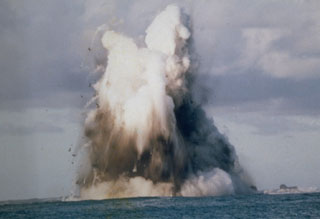Report on Nishinoshima (Japan) — 19 April-25 April 2017
Smithsonian Institution / US Geological Survey
Weekly Volcanic Activity Report, 19 April-25 April 2017
Managing Editor: Sally Sennert.
Please cite this report as:
Global Volcanism Program, 2017. Report on Nishinoshima (Japan) (Sennert, S, ed.). Weekly Volcanic Activity Report, 19 April-25 April 2017. Smithsonian Institution and US Geological Survey.
Nishinoshima
Japan
27.247°N, 140.874°E; summit elev. 100 m
All times are local (unless otherwise noted)
Satellite images of Nishinoshima acquired on 19 April and processed by NASA's Earth Observatory showed an area of hot lava in the crater. According to a news article, observers aboard a plane passing the volcano on 21 April noted intense activity in the crater. Bombs were ejected as high as 100 m above the crater and incandescent rocks rolled down the flanks, reaching the sea. The report noted brown plumes rising from the crater and lava effusing from an area near the top of the vent.
Geological Summary. The small island of Nishinoshima was enlarged when several new islands coalesced during an eruption in 1973-74. Multiple eruptions that began in 2013 completely covered the previous exposed surface and continued to enlarge the island. The island is the summit of a massive submarine volcano that has prominent peaks to the S, W, and NE. The summit of the southern cone rises to within 214 m of the ocean surface 9 km SSE.
Sources: NASA Earth Observatory, Asahi

